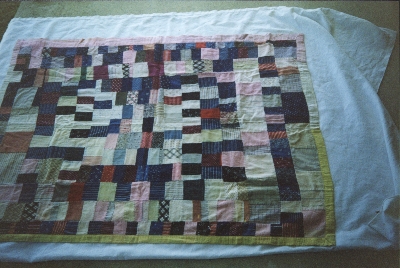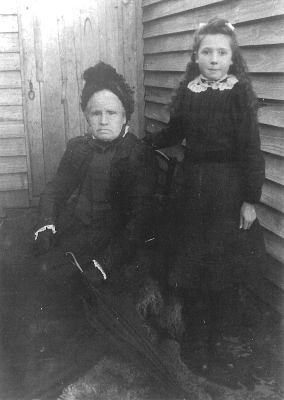Quilt No.550PD - Phyllis Dowling

1170 x 920mm
The exact history of the quilt is not known but it is thought to have been made by Harriet Harris at either Kiandra or 'Glory Hole' in the 1860s. It is now owned by her great grand-daughter, Phyllis Dowling.
"Harriet Harris was born c.1825-1830 in Pedwell, Somerset, England. She was the daughter of John Chapple, a builder, and Mary Sandy. She married Henry Josiah Harris on 2 January 1853 at Trinity Church, Newington, London.
Henry Harris was a butcher and had several trips to Australia as a Ships Butcher before deciding to remain here c.1857.
They had 3 children born in London, Annie, Emma Harriet and Henry George. Harriet and her 3 children arrived in Sydney on the ship 'Herald of the Morning' on 25 June 1858. The family were in Newtown, Sydney when the 4th child, Robert, was born 6th June 1859.
In 1860, following the discovery of gold the family moved to Kiandra, travelling to Twofold Bay by boat and then to Kiandra by bullock dray.
The next child, Catherine Louisa was born there 9 May 1860 followed by Rose Elizabeth 12 September 1864 and finally Oliver John 9 February 1866.
Henry Harris continued with his butchering business in Kiandra but because of the harsh winters had to have somewhere other than Kiandra for his stock in winter so besides the home in Kiandra he purchased a 40 acre block below what is now Yarrangobilly Caves. This property was called 'Glory Hole' and members of the family lived there until 1910.
Although small and primitive in the beginning the 'Glory Hole' home eventually had 5 bedrooms, lounge, dining room, kitchen. hallway and verandah. The house was built of timber split on site.
Both Henry and Harriet are buried in the family grave at 'Glory Hole'. Henry died 17 August 1898 and Harriet 1 August 1904."
[Phyllis Dowling, Tumut 1998]

Related Quilts:
2160 x 1524mm
1220 x 763mm
2743 x 2439mm
2000 x 2000mm
3049 x 2109mm
2530 x 1640mm






